Ragi malt recipe also known as ragi java or ragi porridge is a healthy dish made with finger millet flour, water and jaggery. Ragi also known as finger millet are tiny red seeds packed with nutrition. Ragi is a superfood. Ragi seeds and its flour are used to make various recipes. Soaked and ground ragi seeds or ragi flour are also used to make Ragi Recipes like Ragi Idli, Ragi Dosa and Ragi Mudde.
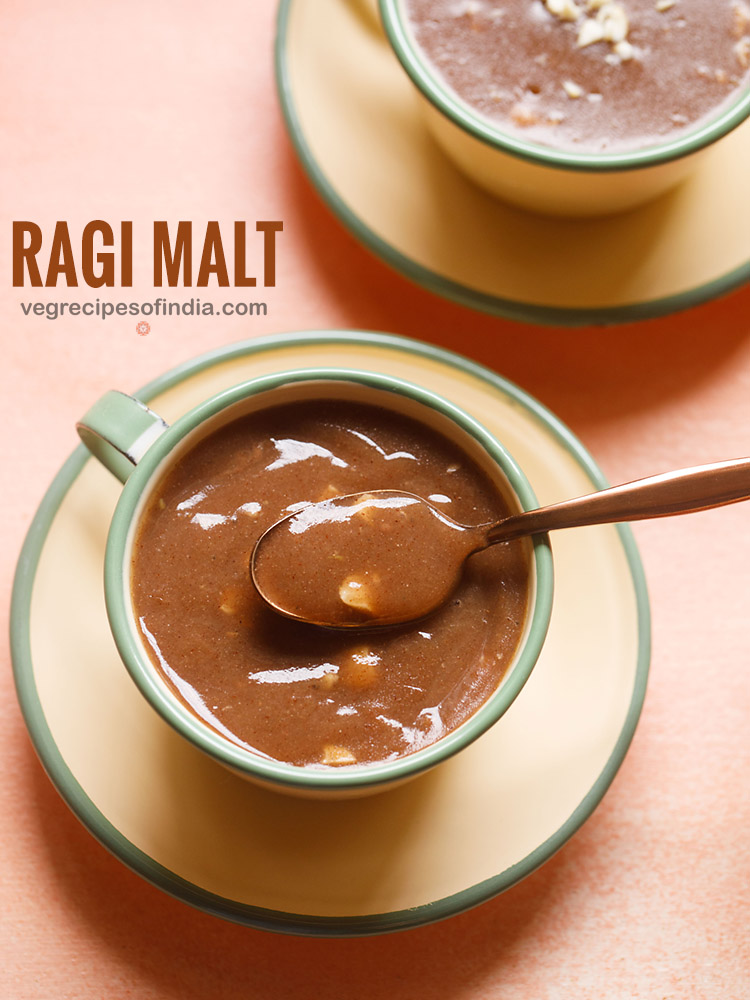
About This Ragi Malt Recipe
Using this technique of making ragi malt won’t give you any lumps. It will be smooth and without any lumps. Very easy to make and Takes less than 15 minutes right from start to finish.
A forgiving recipe and more water or more ragi flour can be added as per your needs. The recipe can be halved, doubled or tripled easily.
Nuts, dry fruits and flavorings of your choice can be added. I always add cardamom powder and a few almonds or cashews.
Only water is used to make ragi java as milk makes it heavy. So this ragi malt recipe is a vegan recipe. Though if you prefer, you can add half-half of water or milk or only milk.
Jaggery is added in the ragi malt instead of sugar. In the absence of jaggery, you can add sugar. For diabetics skip jaggery or sugar entirely.
Both ragi flour and sprouted ragi flour can be used to make this malt recipe.
Are ragi malt or ragi porridge the same ?
Ragi malt is a healthy breakfast drink made with ragi flour or sprouted ragi flour, water or milk. Ragi porridge is a thicker version. though both the names ragi malt and ragi porridge are used interchangeably.
Specifically, malt is the word used for drinks made with sprouted grains. even though I have used ragi flour, but even sprouted ragi flour can be used to make this nutritious drink. I have also not used milk as milk makes the malt heavy. so I avoid adding milk and make the malt with water.
I make ragi malt for breakfast at least twice a week. Thus sharing the recipe. I also make ragi malt with soaked ragi seeds which require some extensive preparation.
Making ragi malt with ragi flour is a breeze and gets done in less than 15 minutes. So sharing this quick method of making ragi malt with ragi flour. I personally prefer making ragi porridge with ragi flour as it gets done quickly.
Ragi porridge has been a tradition in my family from decades. It was given to growing up kids, family members convalescing from an illness and aged family members. From my mother, I have learned many ragi recipes and they have been shared on the blog too.
Variations
- Ragi malt can be made both sweet and savory. In this recipe post, I am sharing the sweet ragi malt recipe. For sweetness I have added jaggery. However sugar or any other sweetener of your choice can also be added instead of jaggery. Just avoid adding honey as it should not be heated.
- For the savory ragi malt version, ragi mixture is cooked in water. Then after cooling in this ragi mixture, buttermilk is added. Some more ingredients like cumin powder, onions, curry leaves etc can also be added. This savory ragi malt is called as ragi ambli and is a cooling drink.
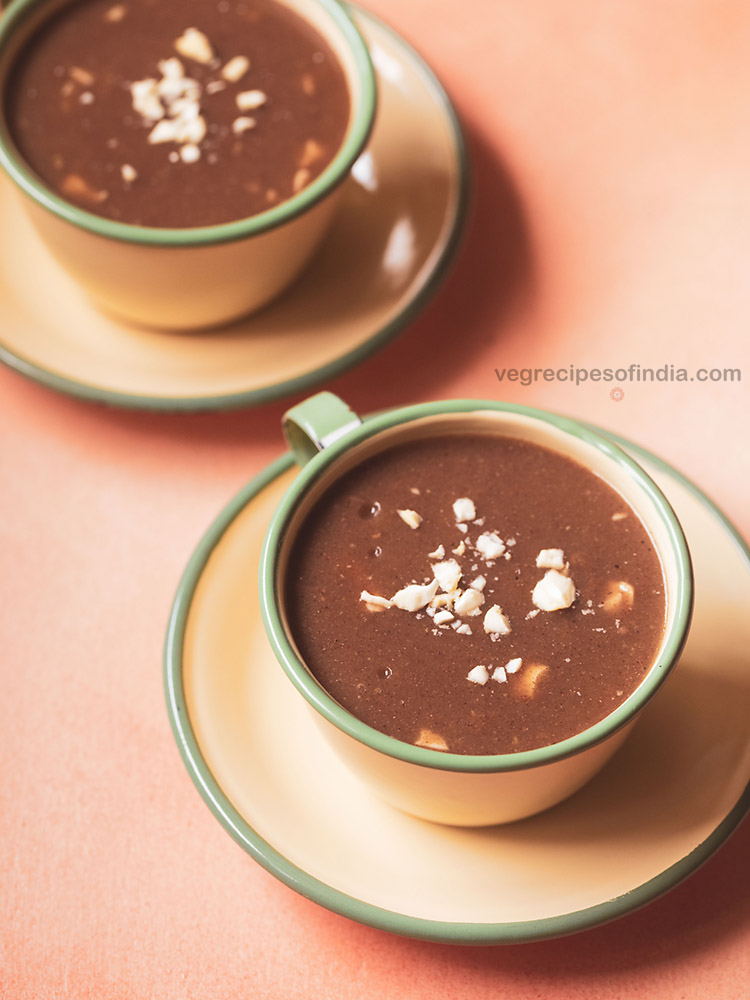
Ragi Malt Health Benefits
- Help in weight loss.
- Keeps the bones strong and prevents conditions like osteoporosis due to ragi being an excellent source of calcium. 100 grams of ragi contains approx 350 mg of calcium. Women should have foods with a good calcium content as with age deficiency of calcium can occur making the bones porous. Thus it is beneficial for women to include ragi in their meals. Ragi is also good for growing up kids.
- Ragi is rich in iron, which can help to ward off anemia.
- Ragi is also a good source of proteins. Thus making it an excellent source for protein intake for vegetarians and vegans.
- Good for people having diabetes.
- Helps in reducing cholesterol.
- Ragi is good for people who have an aggravated pitta dosha.
- Being gluten-free grain, ragi can be easily consumed in a gluten-free diet.
Few points to keep in mind when having ragi
- Ragi has a cooling nature. So best consumed during summers and hot seasons.
- Folks suffering from kidney stone problem should not consume ragi.
- Include more water when having ragi. When foods high in fibre are included in the diet, then more water has to be consumed. Taking less water will cause constipation.
- Have ragi in moderation in your diet. Do not include ragi in excess as it may cause kidney stone problem due to it being a rich source of calcium.
How to make Ragi Malt Recipe
This healthy, wholesome breakfast comes together in just 15 minutes. Here’s how it’s done:
Making ragi slurry
1. Take 4 tablespoons of ragi flour or sprouted ragi flour in a mixing bowl.
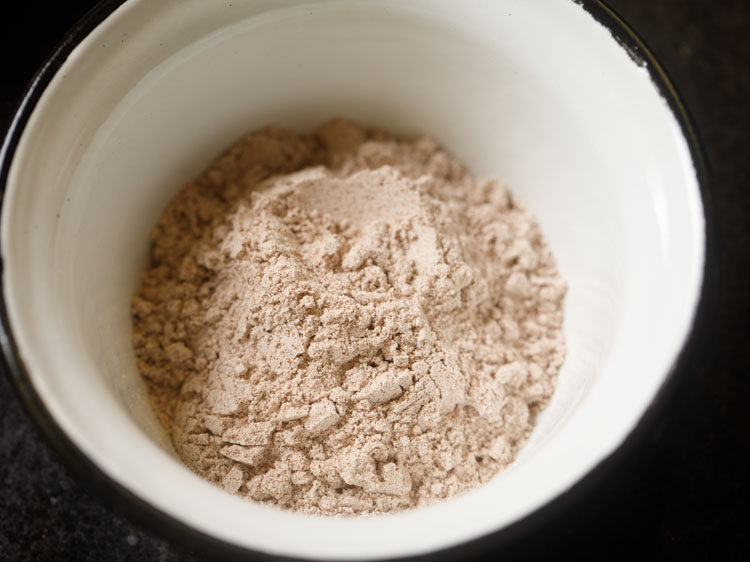
2. Add ½ cup water.
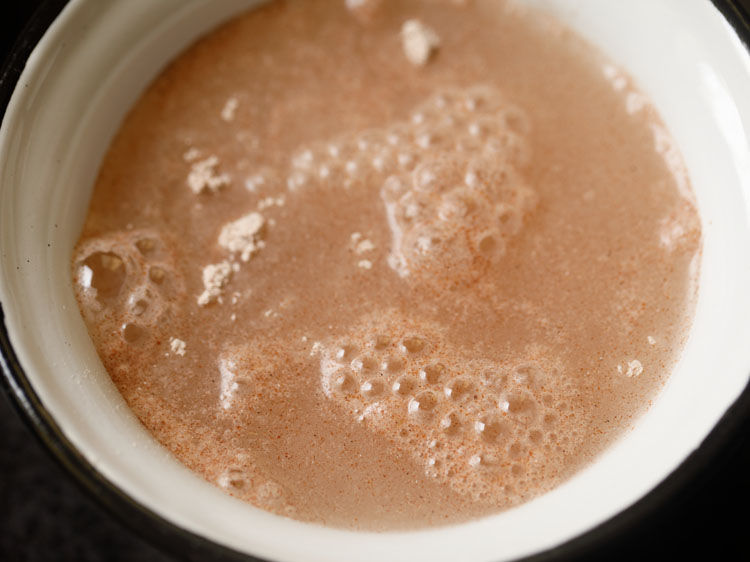
3. Using a small wired whisk or spoon mix the ragi flour with the water very well. There should be no lumps.
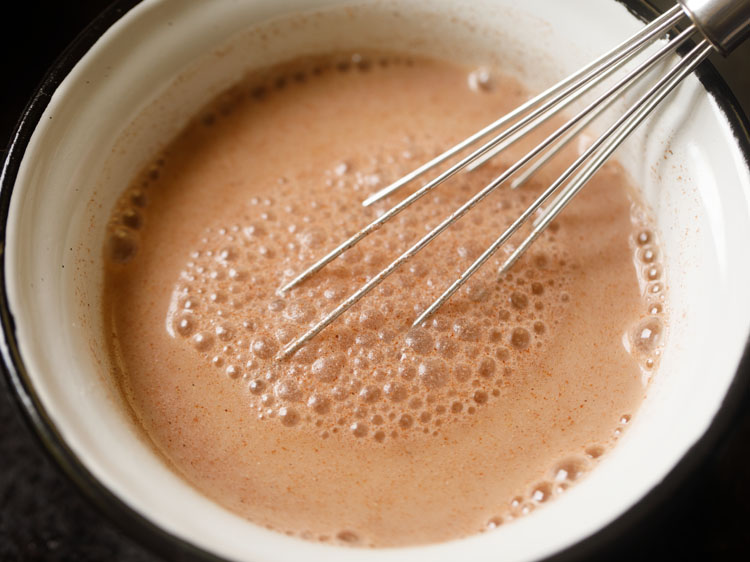
Cooking Ragi
4. In a heavy or thick-bottomed saucepan or pan, take 2 cups of water. Bring the water to a rolling boil on medium to medium-high heat.
Do note that depending on the quality of ragi flour, you can add less or more water. Also for a thinner ragi malt, add more water and for a thick ragi porridge add less water.
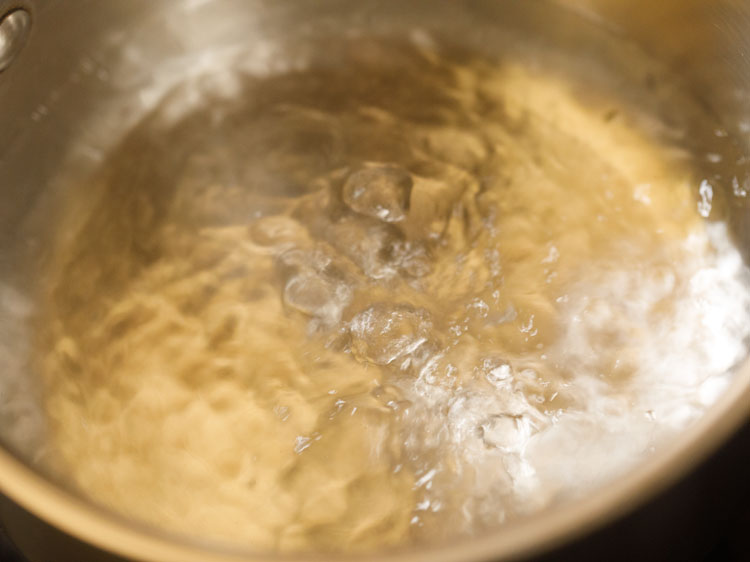
5. Then lower the heat and in a steady stream add the ragi slurry.
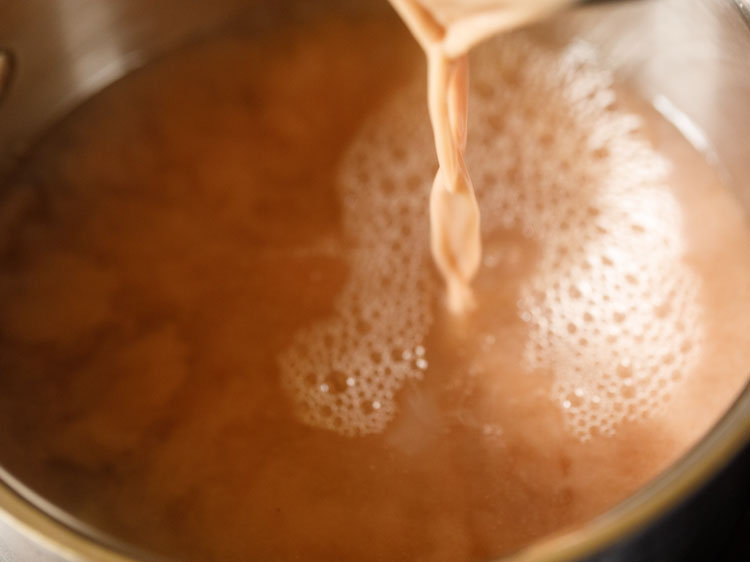
6. Keeping the heat to a low, mix the ragi slurry in the hot water with a wired whisk or spoon.
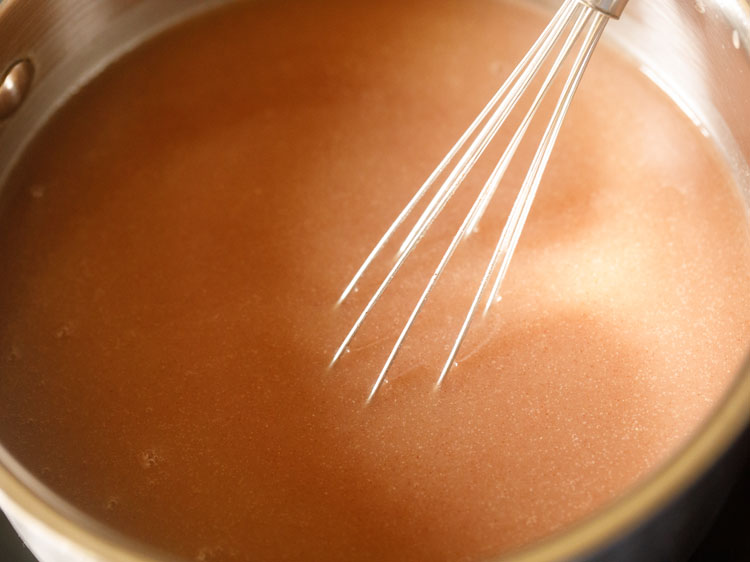
7. Simmer and cook on a low heat. The ragi solution will look thin initially but on cooking further will begin to thicken.
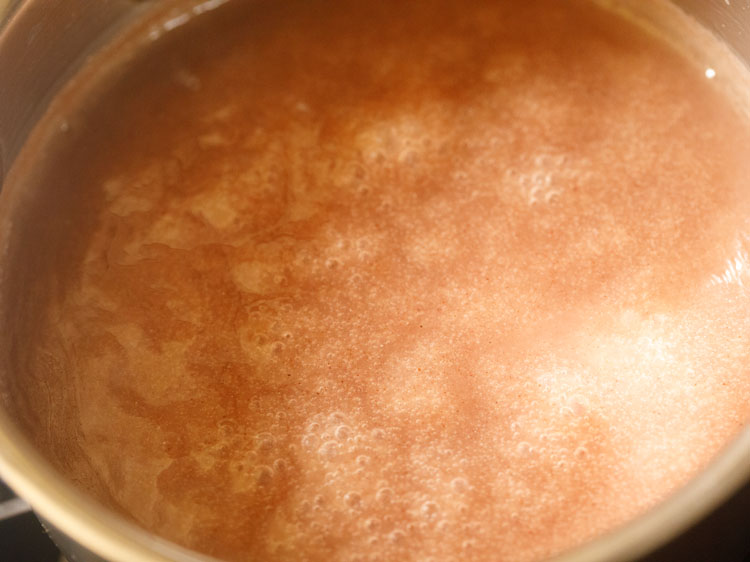
8. In between do stir at intervals with a wired whisk or spoon.
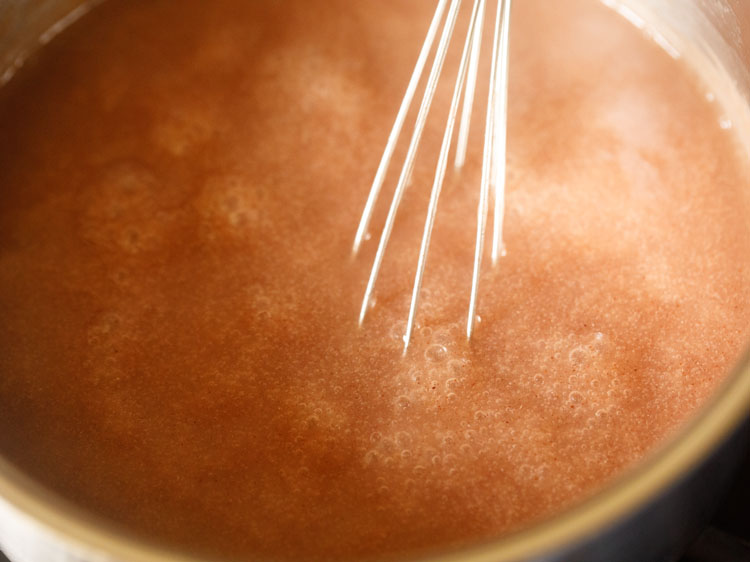
9. The mixture will thicken gradually.
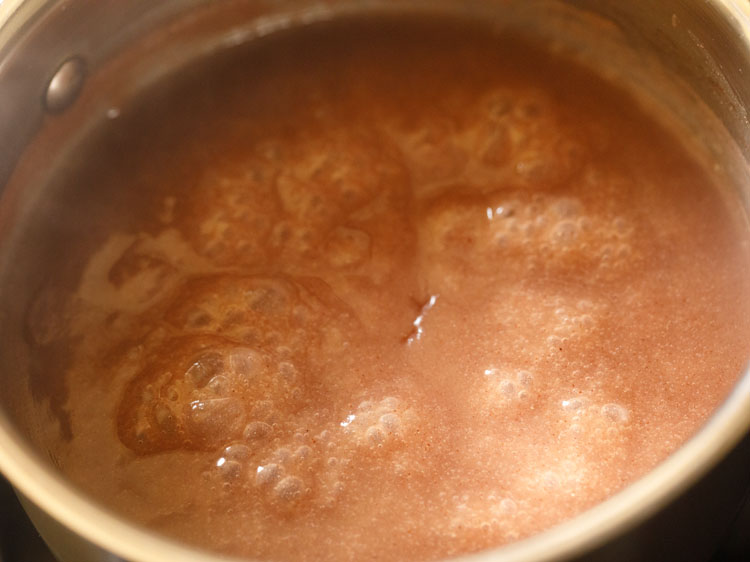
10. Overall cook for 10 to 12 minutes after adding the ragi slurry. The mixture will thicken more by this time. Before proceeding to the next step, the ragi should be completely cooked.
There should be no rawness in the taste. You can take a bit of the mixture in a spoon and taste it to check the raw taste.
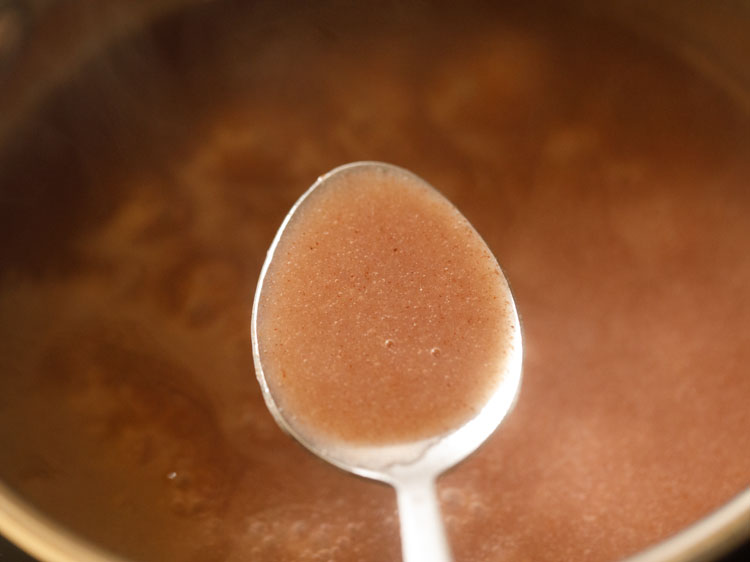
Making Ragi Malt
11. Once the ragi has cooked completely, add 6 tablespoons jaggery powder or add as per taste. You can even add sugar. Sweeteners like jaggery or sugar can also be skipped entirely for a diabetic friendly option.
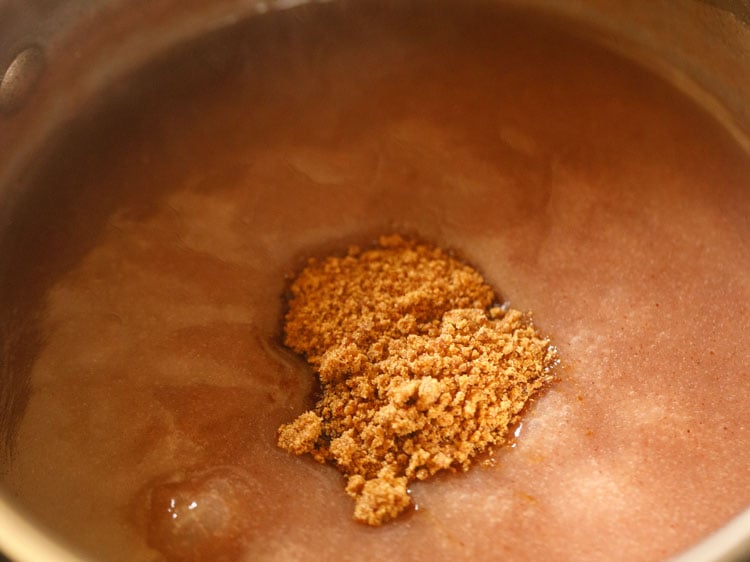
11. Mix again very well till all of the jaggery gets dissolved. If in case the ragi porridge becomes thick then add some more water.
Note on jaggery: I have used organic jaggery powder and thus have not filtered its syrup. If using jaggery with many impurities, then mix it in ¼ cup water in a small pan. Keep the pan on a low to medium flame and stir till all jaggery is dissolved. Then strain the jaggery solution and add to the ragi malt.
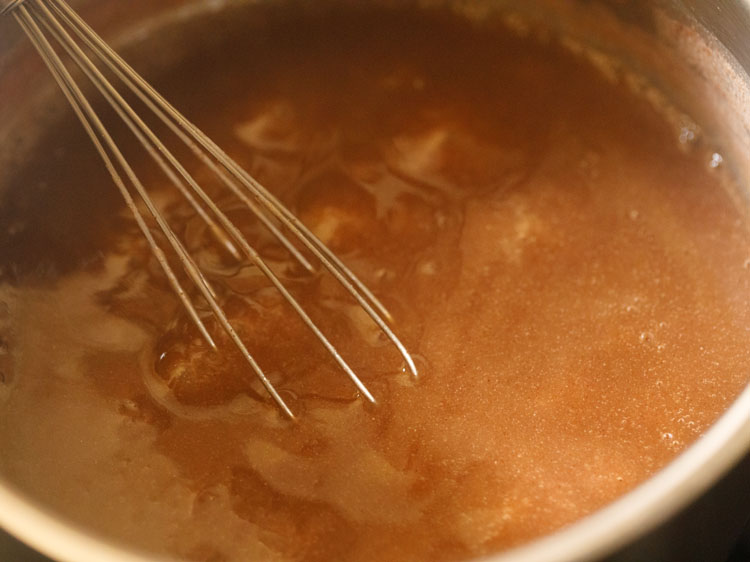
12. Add ¼ teaspoon of cardamom powder.
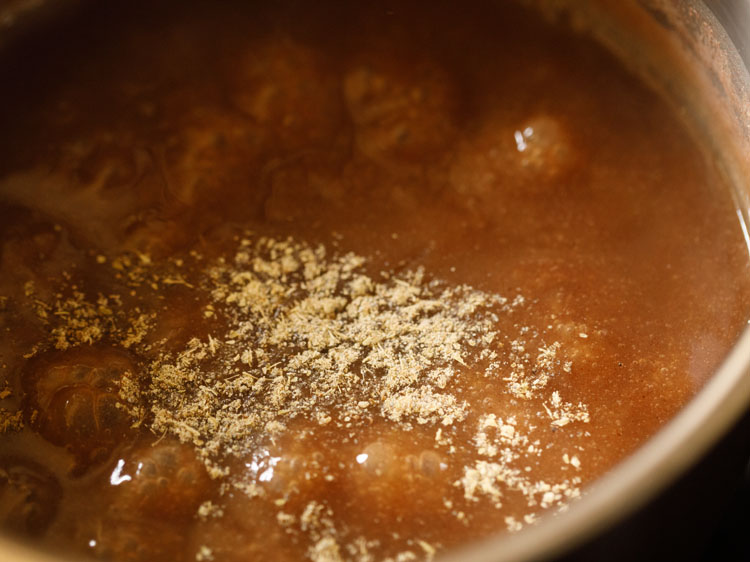
13. Next, add 1 tablespoon chopped cashews or cashew powder. You can even use chopped almonds.
For small kids or toddlers, you can use blanched almond powder. Various dry fruits and nuts or nut powder of your choice like add dates, pistachios, raisins etc can be added. Nuts can also be skipped.
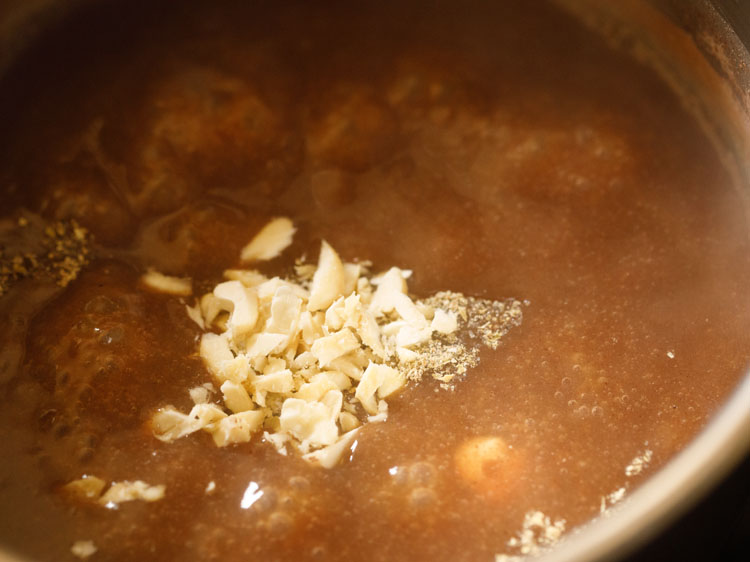
14. Mix very well. The porridge will thicken more on cooling.
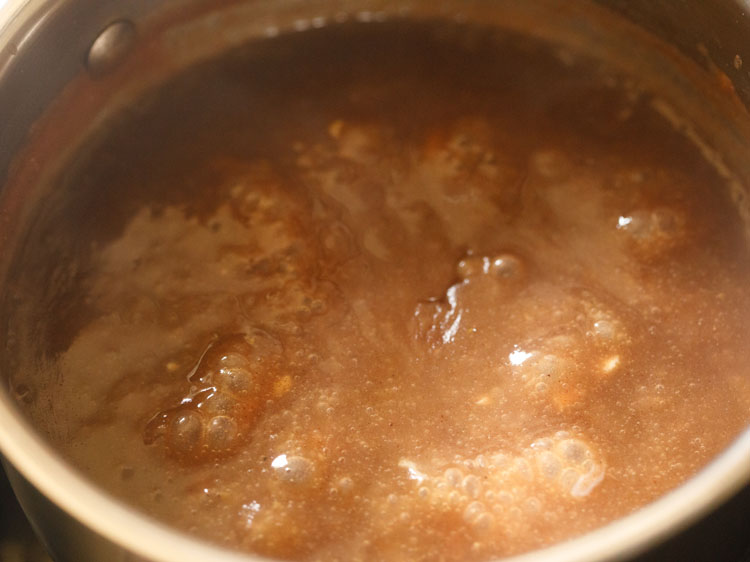
15. Serve ragi malt or ragi java, hot or warm or at room temperature.
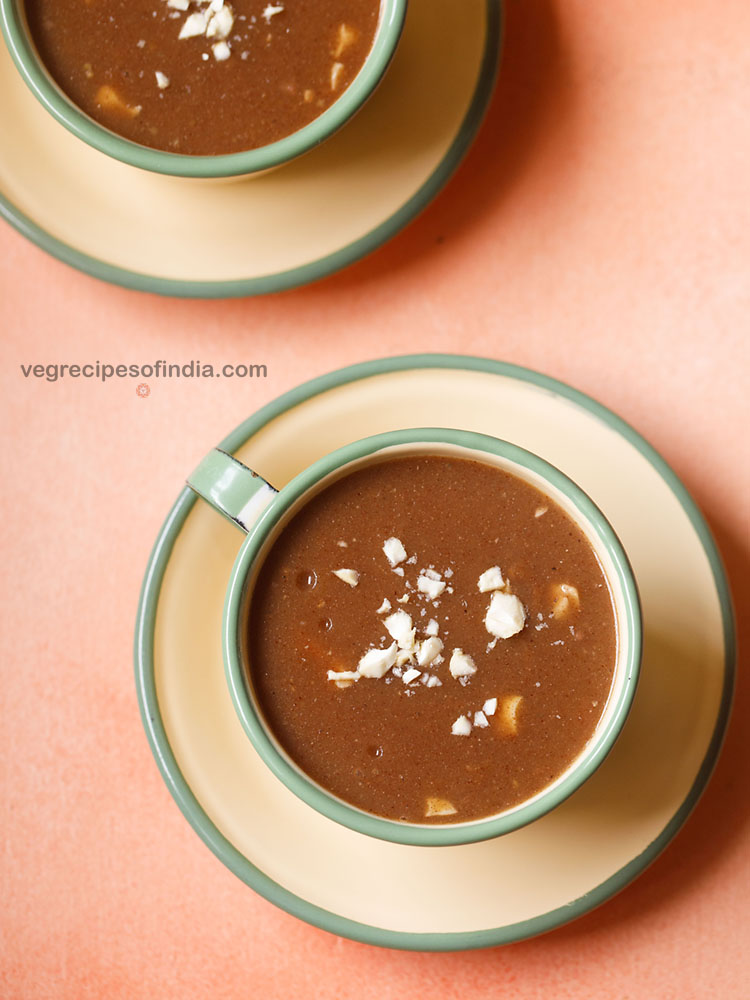
Please be sure to rate the recipe in the recipe card or leave a comment below if you have made it. For more vegetarian inspirations, Sign Up for my emails or follow me on Instagram, Youtube, Facebook, Pinterest or Twitter.
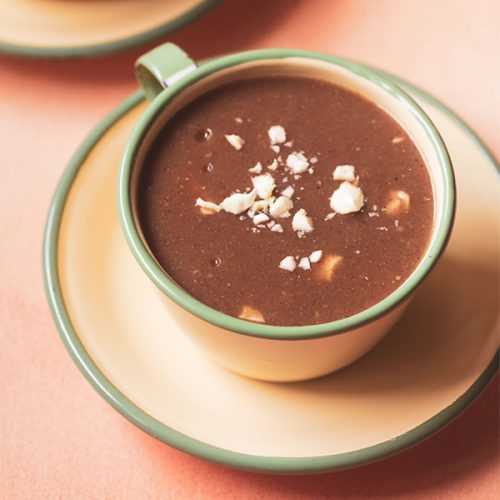
Ragi Malt | Healthy Ragi Java | Ragi Porridge
Ingredients
for ragi slurry
- 4 tablespoons ragi flour or sprouted ragi flour (finger millet flour)
- ½ cup water
other ingredients
- 2 cups water
- 6 tablespoons jaggery powder or add as required – sugar can also be added instead of jaggery
- ¼ teaspoon cardamom powder
- 1 tablespoon chopped cashews – can use chopped almonds or blanched almond powder or a mix of dry fruits or nuts – optional
Instructions
making ragi slurry
- Take 4 tablespoons ragi flour or sprouted ragi flour in a mixing bowl.
- Add ½ cup water.
- Using a small wired whisk or spoon mix the ragi flour with the water very well. There should be no lumps.
cooking ragi
- In a heavy or thick-bottomed saucepan or pan, take 2 cups of water.
- Bring the water to a rolling boil on medium to medium-high flame.
- Then lower the flame and in a steady stream add the ragi slurry. Right before adding the ragi slurry, do stir it once or twice in the bowl.
- Keeping the flame to a low, mix the ragi slurry in the hot boiling water with a wired whisk or spoon.
- Simmer and cook on a low flame.
- In between do stir at intervals with a wired whisk or spoon.
- The mixture will thicken gradually.
- Overall cook for 10 to 12 minutes after adding the ragi slurry. the mixture will thicken more by this time. Before proceeding to the next step, the ragi should be completely cooked. There should be no rawness in the taste. You can take a bit of the mixture in a spoon and taste it to check the raw taste.
making ragi malt
- In this next step, add 6 tablespoons jaggery or add as per taste. You can even add sugar. Sweeteners like jaggery or sugar can also be skipped entirely for a diabetic friendly option.
- Mix again very well till all the jaggery gets dissolved. If in case the ragi porridge becomes thick then add some more water.
- Add ¼ teaspoon cardamom powder and 1 tablespoon chopped cashews.
- You can even use chopped almonds. For small kids or toddlers, you can use blanched almond powder. Various dry fruits and nuts or nut powder of your choice can be added.
- Mix very well. Please do note that this porridge will thicken more on cooling.
- Serve ragi malt hot or warm or at room temperature.
Nutrition Info (Approximate Values)
This Ragi Malt post from the blog archives, first published in May 2019 has been republished and updated on February 2023.












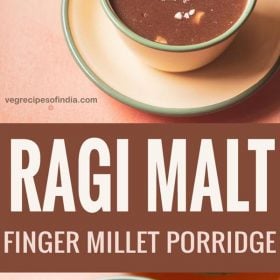
If the flour is made at home, is it better to make it coarse or fine.
Finer flour is better.
Please also start giving calories also of the recipes.
Approximate calories are mentioned in the recipe card.
Liked the blog information and the recipe. Wholesome way to learn and try.
Thanks for detailed information.
Welcome.
Love all your recipes.. obsessed with this malt.
Thank you.
Cooked for father now he is obsessed with it.
I love all Dassana’s recipe. They turn out tasty.
Thanks a lot.
Madam – I appreciate your kindness in sharing your healthy simple step by step recipes for beginners with elaborate photos including narrating the health benefits. May you have a long life.
Thanks Stephn for your kind words.
Dear Dassana,
I keep referring to your recipes every now and then. You explain every step with so much detail, that it is impossible for us to make mistakes while trying. Thank you
hi soumya. firstly thank you. it feels nice to know that the details help. i make sure the while cooking the readers do not make mistakes or errors and that is the reason i end up writing detailed steps. most welcome and happy cooking.
Hi Dasana.. I’m an ardent follower of your site. I’ve tried many recipes and all have come out really well. For this recipe, can you tell me how to make it with whole ragi instead of flour?
thanks meghna. soak ragi overnight in enough water overnight or for 7 to 8 hours. drain all the water. add the soaked ragi in a grinder jar. add water (not much, just enough for the ragi to grind easily). grind to a smooth consistency. pour the ragi batter in a pan. gently heat through. when it becomes warm, add some milk or water if required and to get the consistency you want. continue to simmer and cook on a low to medium-low flame till the porridge is done. keep on stirring often. lastly add sugar or jaggery and nuts. simmer for a minute or two. hope this helps.
What brand you use for jaggery powder.. There are many organic jaggery powder available in market.
i either use organic tattva, fabindia or 24 letter mantra. a few brands i had purchased from amazon, but i do not remember their names now. hope this helps.
6 spoons jaggery tasted too sweet. Is malt supposed to be so sweet or should I put less jaggery?
pihu, did you use correct tablespoon measure or used the spoon we use for eating or serving food. 6 tablespoons of jaggery makes the malt just sweet. it is not very sweet. malt is supposed to be sweet. you can definitely add less jaggery. the amount of sweetness will also depend on the jaggery quality and each person’s preference for sweetness will be less or more. in fact, in any recipe, one can always less or more jaggery or sugar depending on personal preference. hope this helps.
Is one tablespoon measure equal to the spoon we use for eating ?
no. 1 tablespoon is a standard measurement where 1 tablespoon equals 14.78 ml (round it to approx 15 ml). if you compare with teaspoons than 1 tablespoon is 3 teaspoons. eating spoon varies with size. some of them will contain more volume than 1 tablespoon or even less. for getting to learn perfect cooking till you master adding ingredients by approximation (method of andaaz) it is better to buy measuring cups and spoons. you can easily buy them online. for baking, measuring cups and spoons are very helpful.
Thanks for the reply
Thanks for the quick reply.Will try the savory version also.
welcome winnie.
This was awesome. I would really appreciate if you post the savory ragi malt recipe version as well. For health reasons, we are trying to find ways to incorporate ragi in our diet, but the options are too limited right now. Appreciate all your help
thanks sayanti. sure, i do plan to add the savory version too. try adding some ragi flour in the chapati atta. i do that when i make chapatis. for 3 cups of wheat flour, you can add about 1/3rd to 1/2 cup of ragi flour.
i will try to add some more ragi recipes.
First of all let me thank you for providing valuable insights and the detailed explanation on ragi/malt. I never knew the actual meaning of malt till I read this☺
Made this porridge today.. Skipped sugar,added mixed dry fruits.Very refreshing and cool in this hot summer.
For the savoury version how much buttermilk is to be added in this recipe?Please advise.
welcome winnie. ragi drinks are cooling. the buttermilk one is more cooling. depending on the consistency you want from medium to thin to runny, you can add the quantity of buttermilk. add buttermilk once the cooked ragi mixture has cooled completely. when the ragi mixture cools, it will thicken more. about 1 to 1.5 cups of buttermilk should be fine.